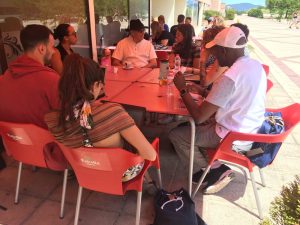Territorial Approach and Tourism
By Sinead Flannery, Karina Gonzales, and Laura Garcia Herrero
It may be Saturday but ICRPS does not stop! Since the university was asleep (i.e., closed for the day), we met at the Plaça Civica so campus security could let the group in

L’Estany village
to the Facultat d’Economia i Empresa. As with all ICRPS mornings, there was no time to waste. We began with a Moaines debriefing session led by Victoria Soldevila (Universitat Rovira i Virgili). The group discussed how Moaines was developing in terms of agrifood systems, rural-urban linkages, climate change and rural business. An immediate observation by the students was the traffic our motorcoach encountered as we were leaving the area. This influx at the end of the day–or rather the end of the work week–were people who owned second homes in Moaines and were commuting from Barcelona. This led to a discussion about the tax structure in Catalonia: who pays what and where the money goes. Bottom line? It’s complicated.

Agri-food group discussion
After the Moaines reflection, we heard three lectures about territorial approach. First up was Francesca Regoli (UNIBO) who introduced the concept of territorial capital assets in the form of natural, human, social, economic, cultural and institutional resources. Every region is characterized not only by boundaries and landscape but also by norms, cultural insights and interactions between the social, economic and environmental features. A community based approach to territorial capital assets is facilitated by a community-based approach, which recognizes the complex ecology and further adds value by recognizing the potential for social cohesion. On the contrary, de-territorialization occurs when interaction between territory and people are not synergistic.
The second lecture was presented by John Bryden (NIBIO) about economic performance in rural areas and the importance of funds to reduce the imbalance between rural and urban areas. Differential economic performance can occur as a result of 1) cultural traditions and social arrangements, 2) peripherality and infrastructure, 3) governance, institutions and investment, 4) entrepreneurship, 5) economic structures and organization, and 6) human resources and demography. Differences and development can only be understood using a long-term, transdisciplinary and comparative framework that focuses on local factors. Dr. Bryden ended his lecture with an intriguing statement — territorial policies in the EU “are tinkering at the edges”.
The third and last morning lecture was by Mikael Akimowicz (LEREPS) who gave students the task of defining territory. It’s a mystery if anyone came up with a definition that captured the shared attributes (history), a social construct (place vs. space), interacting actors (social networks), and informal relationships (based on trust and reciprocity). This was a stimulating task to start a conversation about the impact of farmland policies on farmers’ investments in peri-urban areas. Mikael cited different approaches such as neo-classical and territorial to understand the definition of territory.
Finally, we had a coffee break. Since the cafeteria was closed, we were treated to sweets and fruit including really good cherries. Thanks, Clara!
After the break we regrouped for a session on territorial approach and tourism. Phil Loring (UofS) started us off with a lecture on rural development in isolated regions. Alaska was presented as a case study and referenced how the great expanse of the state, lack of infrastructure, harsh climate and cultural transitions are creating manufactured insecurities related to food, water and healthcare. Dr. Loring introduced the concept of socio-technical design which is development that thinks about how it will feed back to the community. Current rural development has tried to fix rurality by making rural areas more urban, however, design based on place promotes design based on rural needs. The group was left to ponder questions such as 1) what is social value?, and 2) how are governance and policy managed?
The last three presentations were a blur…
Bernat Vilarasau (Aj. Vic) discussed the importance of adapting tourism according to the landscape, culture, and internal values of the area. In other words, nature should acts as the driver. In creating an economy based on natural resources, a major barrier is that the local government must find the balance between supporting private initiative and public good.
Francesca Rigoli (UNIBO) gave her second presentation of the day about how rural tourism is a composite notion with different focus areas and approaches. For example, a territorial based approach can lead to a product-territory relationship (prestige of product) or territory-product relationship (tourist aims to visit area). It’s important to understand that tourism can work in one village but not in a nearby village. This underlines the importance of thinking locally and acting globally, as well as the role of rural communities as facilitators and drivers of change.

Dr-Fuller discusses the fallacy of tourism as a rural development strategy
Toni Fuller (CAU) provided us with a very interesting presentation on the fallacy of tourism as a rural development solution by using China as a case study. Dr. Fuller presented us with a case where management of tourism totally modified the landscape and the management of economic activity in South China. South China is a distinct rice terrace system many centuries old which attracts thousands of tourists annually. However, the people and culture are having a severe negative impact impact on this landscape. Locals, previously farmers, have become waiters and cleaners in hotels that have been built on their former land. In addition, the rice terraces are at increased risk and will deteriorate to an unsustainable level primarily due to a lack of water as result of an increase in the number of hotels in this area. However, despite these negative impacts on this area in South China, this example is still viewed as a success story in rural development! Therefore highlighting the crucial role local and regional policies have to play in protecting the local people.

Group discussion but outdoors with faculty mentors
As it was Saturday and the campus was closed we were treated to lunch at the Campus Hotel. A fantastic buffet with a great selection of food was offered to us with the option to quench our thirst with a glass of vino, beer or an ice cold mineral! During the lunch we had the opportunity to engage with fellow ICRPS participants and faculty. Following lunch all students broke away into their individual groups to begin discussing our own individual projects and the group project as a whole under the guidance of faculty members. This session allowed us to receive feedback, guidance and recommendations on our individual projects. The key message from this discussion was to keep the project focused by identifying specific research questions. This helps to keep the project focused and prevent it from becoming a ‘monster project’! For the purpose of the group project it was recommended that we each choose one research question we want to address and keep it simple – ‘It doesn’t have to be perfect’! The purpose of the project is to be able to demonstrate to faculty our understanding of how a comparative study works while identifying the challenges that accompany a comparative study.
